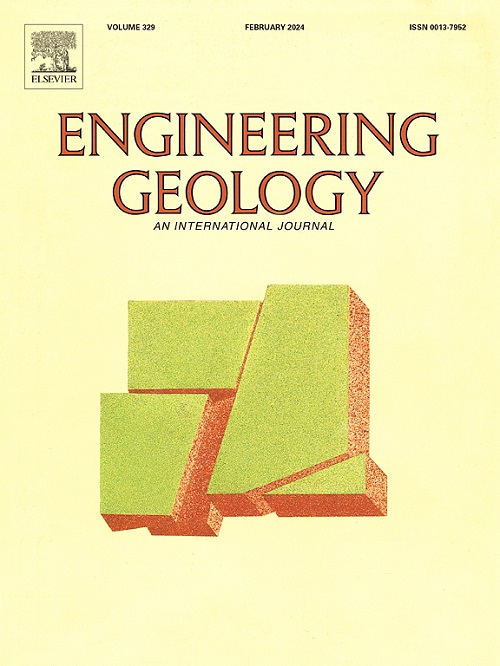Effects of dehydration on the residual shear strength of hydrous material in high-velocity shearing
IF 6.9
1区 工程技术
Q1 ENGINEERING, GEOLOGICAL
引用次数: 0
Abstract
The residual shear strength of materials on the shear surface is a crucial parameter in controlling the landslide movement and could be influenced by the sliding velocity. Recent studies suggested that dehydration of hydrous materials due to friction heating during high-velocity shearing and under high normal stress may weaken shear strength. However, the underlying mechanisms remain unclear. To investigate this, a series of ring shear tests on halloysite nanoparticles (ADH) were conducted in both their original (ADHorig) and pre-dried at 500 °C (ADH500) states, under normal stress of 200 kPa and varying shear velocities. Results show the residual shear strengths (τr) increase slightly with shear velocity (V) at low velocities (0.1–10 cm/s), but decrease at higher velocities, with a sharp around 210 cm/s, and with τr for ADHorig being half of that of ADH500. Estimating the increasing temperature of the shear surface and X-ray diffraction (XRD) analysis on the post-test samples around the shear zone confirmed sample dehydration during shearing. Moreover, the dehydration of the sample during high-velocity shearing can result in the release of water vapor due to flash heating. It is inferred that the vapor may elevate the pressure along the sliding surface, consequently reducing the shear strength. These findings provide valuable insights into the role of sample dehydration in shear strength reduction, enhancing the understanding of landslide dynamics.
脱水对含水材料高速剪切残余抗剪强度的影响
剪切面上材料的残余抗剪强度是控制滑坡运动的重要参数,并受滑动速度的影响。最近的研究表明,在高速剪切和高法向应力下,由于摩擦加热导致的脱水可能会降低含水材料的抗剪强度。然而,潜在的机制仍不清楚。为了研究这一点,在200 kPa的正应力和不同的剪切速度下,对高岭土纳米颗粒(ADH)在原始状态(adhorg)和500 °C的预干燥状态(ADH500)进行了一系列环剪切试验。结果表明:低速时(0.1 ~ 10 cm/s),残余剪切强度τr随剪切速度(V)略有增大,高速时(210 cm/s左右),残余剪切强度τr为ADH500的一半;通过对剪切面温度升高的估算和对剪切带周围试样的x射线衍射(XRD)分析,证实了试样在剪切过程中发生脱水。此外,试样在高速剪切过程中的脱水会由于闪蒸加热而导致水蒸气的释放。由此推断,蒸汽可能会升高沿滑动面的压力,从而降低抗剪强度。这些发现为样品脱水在抗剪强度降低中的作用提供了有价值的见解,增强了对滑坡动力学的理解。
本文章由计算机程序翻译,如有差异,请以英文原文为准。
求助全文
约1分钟内获得全文
求助全文
来源期刊

Engineering Geology
地学-地球科学综合
CiteScore
13.70
自引率
12.20%
发文量
327
审稿时长
5.6 months
期刊介绍:
Engineering Geology, an international interdisciplinary journal, serves as a bridge between earth sciences and engineering, focusing on geological and geotechnical engineering. It welcomes studies with relevance to engineering, environmental concerns, and safety, catering to engineering geologists with backgrounds in geology or civil/mining engineering. Topics include applied geomorphology, structural geology, geophysics, geochemistry, environmental geology, hydrogeology, land use planning, natural hazards, remote sensing, soil and rock mechanics, and applied geotechnical engineering. The journal provides a platform for research at the intersection of geology and engineering disciplines.
 求助内容:
求助内容: 应助结果提醒方式:
应助结果提醒方式:


